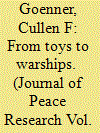|
|
|
Sort Order |
|
|
|
Items / Page
|
|
|
|
|
|
|
| Srl | Item |
| 1 |
ID:
100390


|
|
|
|
|
| Publication |
2010.
|
| Summary/Abstract |
The United States recently proposed to sell Saudi Arabia advanced weaponry worth 20 billion dollars over the next 10 years. The volume of trade, while significant, is second in the news headline that the United States would provide Saudi Arabia with precision-guided bombs, upgrades to its fighters, and new naval vessels. Trade of strategic commodities, such as armaments, suggests a strong interdependence between countries, which may influence international relations differently than the same volume of toys traded between nations. The author posits the volume and pattern of commodities that countries trade with each other are both relevant to interstate conflict. Commodities are heterogeneous and thus vary in terms of their strategic importance, substitutability, and ease of expropriation. This heterogeneity, along with the volume of trade, influences the opportunity cost of lost trade caused by conflict. This article empirically examines whether the pattern of trade is relevant to conflict for the period 1962-2000. The results from both single and simultaneous equations models indicate that increasing the share of bilateral trade in energy, non-ferrous metals, and electronics increases conflict, whereas for chemicals and arms it reduces conflict. Differences in these strategic commodities' elasticity of import demand and export supply, along with their ease of expropriation, contribute to the heterogeneous effects.
|
|
|
|
|
|
|
|
|
|
|
|
|
|
|
|
| 2 |
ID:
124976


|
|
|
|
|
| Publication |
2013.
|
| Summary/Abstract |
Existing studies of intergovernmental organizations (IGOs) and militarized conflict focus on dyadic counts of shared IGO membership. However, dyadic approaches are inconsistent with the basic properties of IGOs. Because IGOs are multilateral organizations, shared membership necessarily involves ties to third parties. This article employs network analytics to develop a novel explanation of how third-party IGO ties reduce militarized conflict. The analysis first examines the 'structural similarity' of states, defined by the extent to which states share similar patterns of IGO membership with relevant third parties. High levels of structural similarity indicate that states interact with a common set of IGO collaborators. The analysis then shows that micro-level changes in IGO membership effect changes in structural similarity, leading to the macro-level phenomenon of 'network convergence,' wherein states increasingly collaborate with the same third parties over time. Substantively, convergence results in increased overlap and integration between states' respective local networks of IGO partners. Because network convergence is costly, involving a combination of IGO-based accession, sovereignty, and alignment costs, it is unlikely to be pursued by purely exploitative state types. Consequently, convergence provides cooperative types with a mechanism for signaling a preference for cooperation over conflict. These credible signals in turn establish mutual trust among cooperators and effectively reduce the risk of militarized conflict. Extensive empirical analysis shows that, in fact, network convergence strongly correlates with a decline in militarized dispute initiations. The more that states collaborate with one another's IGO partners, the less likely they are to fight.
|
|
|
|
|
|
|
|
|
|
|
|
|
|
|
|
|
|
|
|
|